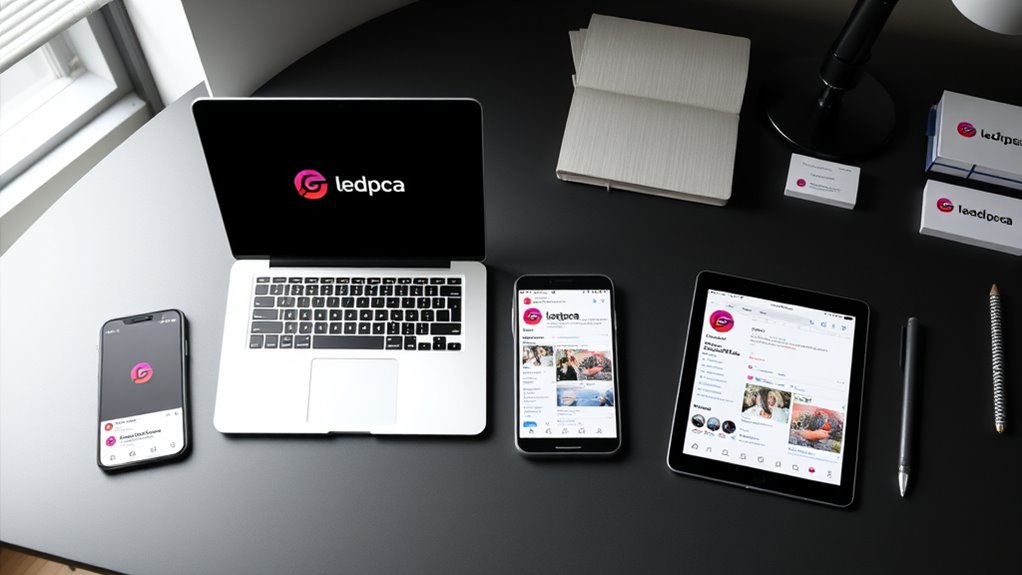To present a professional image across platforms, guarantee your branding is consistent in tone, visuals, and messaging. Develop clear brand guidelines that detail your logo, color palette, fonts, and voice. Regularly review your content to keep everything aligned and cohesive. Using these strategies helps build trust, recognition, and loyalty with your audience. Keep exploring to discover more effective ways to strengthen your brand presence across every touchpoint.
Key Takeaways
- Develop comprehensive brand guidelines detailing visual elements and brand voice for all platforms.
- Maintain uniformity in logo usage, color schemes, typography, and imagery across digital and print channels.
- Use a consistent tone, style, and messaging to reinforce your brand voice on social media, emails, and ads.
- Regularly review and update content to ensure alignment with your brand standards and identity.
- Train team members on branding best practices to ensure cohesive presentation and professional image everywhere.

Have you ever noticed how strong brands maintain a clear and recognizable image across all platforms? That consistency isn’t accidental; it’s a deliberate strategy that helps you build trust and recognition with your audience. At the heart of this effort are two critical elements: your brand voice and visual identity. These components work together to ensure your brand feels cohesive, professional, and memorable no matter where your audience encounters it.
Your brand voice is the tone, style, and personality you communicate through your messaging. It’s what makes your brand unique and relatable. When you define your brand voice, you set a standard for how you speak to your audience across social media, website content, emails, and advertising. For example, if your brand voice is friendly and approachable, every piece of communication should reflect that, whether it’s a tweet, a blog post, or a customer service interaction. Consistency in your brand voice helps your audience recognize your brand instantly and feel a connection, fostering loyalty over time. When your messaging varies wildly across platforms, it creates confusion and dilutes your brand’s impact.
Alongside your voice, your visual identity provides a visual language that reinforces your brand’s personality. This includes your logo, color palette, typography, and imagery style. When your visual identity is consistent, it creates a visual footprint that your audience can easily identify. Your website, social media profiles, packaging, and advertisements should all align visually, creating a seamless experience that projects professionalism. For example, if your brand uses bold colors and modern fonts, every touchpoint should reflect that style. This consistency makes your brand look polished and trustworthy, encouraging customers to engage confidently with your business. Additionally, maintaining consistency in bank operating hours and branch services can enhance customer trust and satisfaction by ensuring they know exactly when and how they can access your services.
Maintaining a consistent visual identity and brand voice isn’t just about aesthetics or tone; it’s about creating a unified experience that resonates with your audience. When your messaging and visuals are aligned, your brand becomes more than just a logo or a slogan — it turns into a trustworthy presence in your customers’ minds. To achieve this, you need to develop clear brand guidelines that specify how your brand voice and visual elements should be used across all platforms. Regularly reviewing your content and designs ensures everything remains aligned with your core identity. When you prioritize consistency, you build a professional image that stands out, encourages loyalty, and ultimately drives growth.
Frequently Asked Questions
How Often Should Branding Elements Be Reviewed and Updated?
You should review your branding elements at least once a year with a brand audit to guarantee consistency and relevance. If you notice your visual refresh looks outdated or doesn’t align with your evolving brand identity, update it promptly. Regular reviews help maintain a professional image across platforms, keeping your branding fresh and engaging. Stay proactive, and don’t wait too long between updates to keep your brand strong and cohesive.
What Tools Can Help Ensure Branding Consistency Across Platforms?
Did you know that 60% of consumers expect consistent branding across all platforms? To guarantee this, use tools like Canva, Adobe Creative Cloud, or Brandfolder to manage your brand style and visual identity. These tools help you maintain uniform colors, logos, fonts, and messaging, making your brand easily recognizable. They streamline collaboration, so your team stays on the same page and projects stay aligned with your brand standards.
How Do I Handle Branding Differences for International Audiences?
To handle branding differences for international audiences, focus on cultural adaptation and localization strategies. You should tailor your messaging, visuals, and tone to resonate with each region’s cultural norms and preferences. Research local customs and language nuances, then adapt your content accordingly. This approach guarantees your brand remains consistent while respecting diverse audiences, fostering trust and engagement worldwide. Always stay flexible and open to feedback to refine your localization efforts effectively.
What Are Common Branding Mistakes to Avoid?
Avoid neglecting your visual identity and brand voice, as these are essential to your professional image. Don’t assume one size fits all; inconsistent branding can confuse your audience. Steer clear of overly complicated logos or messaging, and guarantee your tone remains authentic across platforms. By maintaining a cohesive visual identity and a clear brand voice, you project reliability and professionalism, keeping your brand’s reputation strong and engaging.
How Can Branding Consistency Improve Customer Trust?
Branding consistency boosts customer trust by strengthening brand recognition, making it easier for customers to identify and remember you. When your messaging, visuals, and tone stay uniform across platforms, it shows professionalism and reliability. This consistency fosters customer loyalty because people feel confident in your brand’s authenticity. As a result, they’re more likely to choose you over competitors, knowing they can expect a seamless, trustworthy experience every time they engage with your brand.
Conclusion
So, now that you’ve mastered consistent branding, go ahead and dazzle the world with your perfectly polished image—because nothing screams professionalism like a logo that matches your Instagram filter and a tagline that’s as uniform as your morning coffee order. Remember, if you’re going to be forgettable, at least make it stylish. Keep it consistent, keep it professional, and maybe—just maybe—your brand will finally get the recognition it secretly craves. Cheers to looking the part!





